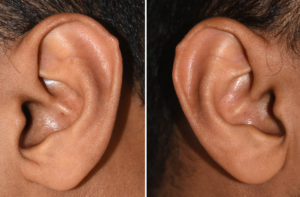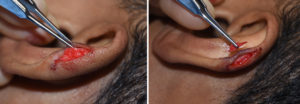Background: The ear, small in size that it is, has a very complex shape. Composed of numerous hills and valleys within its skin-cartilage composition, it has a convoluted topography as a result of its embryologic development. The outer ear achieves its shape through the merger of six hillocks which are derived from the first and second pharyngeal arches. This results in the tragus, crus and helix coming from the first three hillocks and the antihelix, antitragus and lobule coming rom the last three hillocks. As the embryonic ear migrates up from the neck to become a unified structure, it is a virtual miracle that it rests most of the time in a normal looking ear.
But with the hillocks merging and fusion needed to create an intact ear as we know it, there are lots of opportunities for structural malformations to occur. Some of these are quite major, such as microtia, but many are much more minor alterations in the cartilage framework. One such small ear malformation are tubercles, most commonly known as Darwin’s tubercle. These are raised cartilage thickenings on the helical rim usually located at the junction of the upper and middle thirds. It often occurs bilaterally and, while often purported to have a genetic basis, that remains unclear.
While the reason or function of these ear tubercles is uncertain, the derivation of its name and presumed relevance is interesting. While ear tubercles had been previously noted by others, it was Charles Darwin who described it as an atavistic feature. He drew the conclusion that their presence confirmed the common ancestry between man and primates, thus linking his name to the ear anomaly to the present day. While the validity of this association has never been proven, they are a unique feature of the ear that is an identifying feature to the few people who have them.



Case Highlights:
1) The ear is exposed to a wide variety of shape malformations due to its complex embryologic development of which one of the most minor and easily correctable are ear tubercles.
2) Ear or Darwin’s tubercles are accessory cartilage developments along the upper helical rim.
3) Darwin’s tubercles can be removed through a small incision on the lateral surface of the helical rim.
Dr. Barry Eppley
Indianapolis, Indiana




